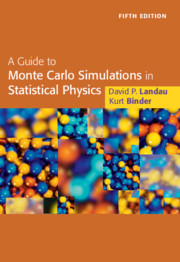Book contents
- A Guide to Monte Carlo Simulations in Statistical Physics
- A Guide to Monte Carlo Simulations in Statistical Physics
- Copyright page
- Contents
- Preface
- 1 Introduction
- 2 Some necessary background
- 3 Simple sampling Monte Carlo methods
- 4 Importance sampling Monte Carlo methods
- 5 More on importance sampling Monte Carlo methods for lattice systems
- 6 Off-lattice models
- 7 Reweighting methods
- 8 Quantum Monte Carlo methods
- 9 Monte Carlo renormalization group methods
- 10 Non-equilibrium and irreversible processes
- 11 Lattice gauge models: a brief introduction
- 12 A brief review of other methods of computer simulation
- 13 Monte Carlo simulations at the periphery of physics and beyond
- 14 Monte Carlo studies of biological molecules
- 15 Emerging trends
- Index
- References
11 - Lattice gauge models: a brief introduction
Published online by Cambridge University Press: 24 November 2021
- A Guide to Monte Carlo Simulations in Statistical Physics
- A Guide to Monte Carlo Simulations in Statistical Physics
- Copyright page
- Contents
- Preface
- 1 Introduction
- 2 Some necessary background
- 3 Simple sampling Monte Carlo methods
- 4 Importance sampling Monte Carlo methods
- 5 More on importance sampling Monte Carlo methods for lattice systems
- 6 Off-lattice models
- 7 Reweighting methods
- 8 Quantum Monte Carlo methods
- 9 Monte Carlo renormalization group methods
- 10 Non-equilibrium and irreversible processes
- 11 Lattice gauge models: a brief introduction
- 12 A brief review of other methods of computer simulation
- 13 Monte Carlo simulations at the periphery of physics and beyond
- 14 Monte Carlo studies of biological molecules
- 15 Emerging trends
- Index
- References
Summary
Lattice gauge theories have played an important role in the theoretical description of phenomena in particle physics, and Monte Carlo methods have proven to be very effective in their study. In the lattice gauge approach a field theory is defined on a lattice by replacing partial derivatives in the Lagrangian by finite difference operators. For physical systems a quantum field theory on a four-dimensional space–time lattice is used, but simpler models in lower dimensions have also been studied in the hope of gaining some understanding of more complicated models as well as for the development of computational techniques. The present chapter is not at all intended to give a thorough treatment, but rather to convey the flavor of the subject to the non-expert.
- Type
- Chapter
- Information
- A Guide to Monte Carlo Simulations in Statistical Physics , pp. 465 - 483Publisher: Cambridge University PressPrint publication year: 2021



